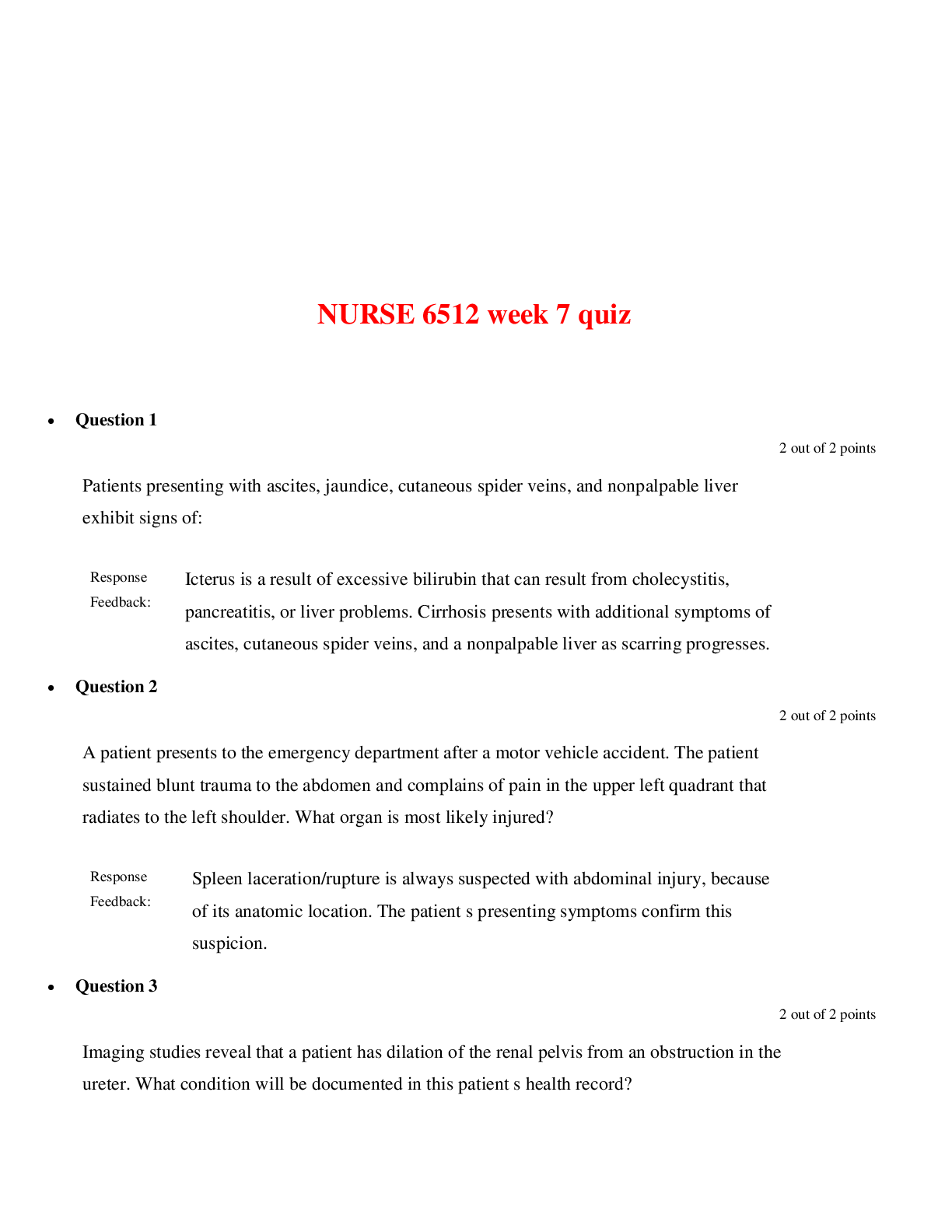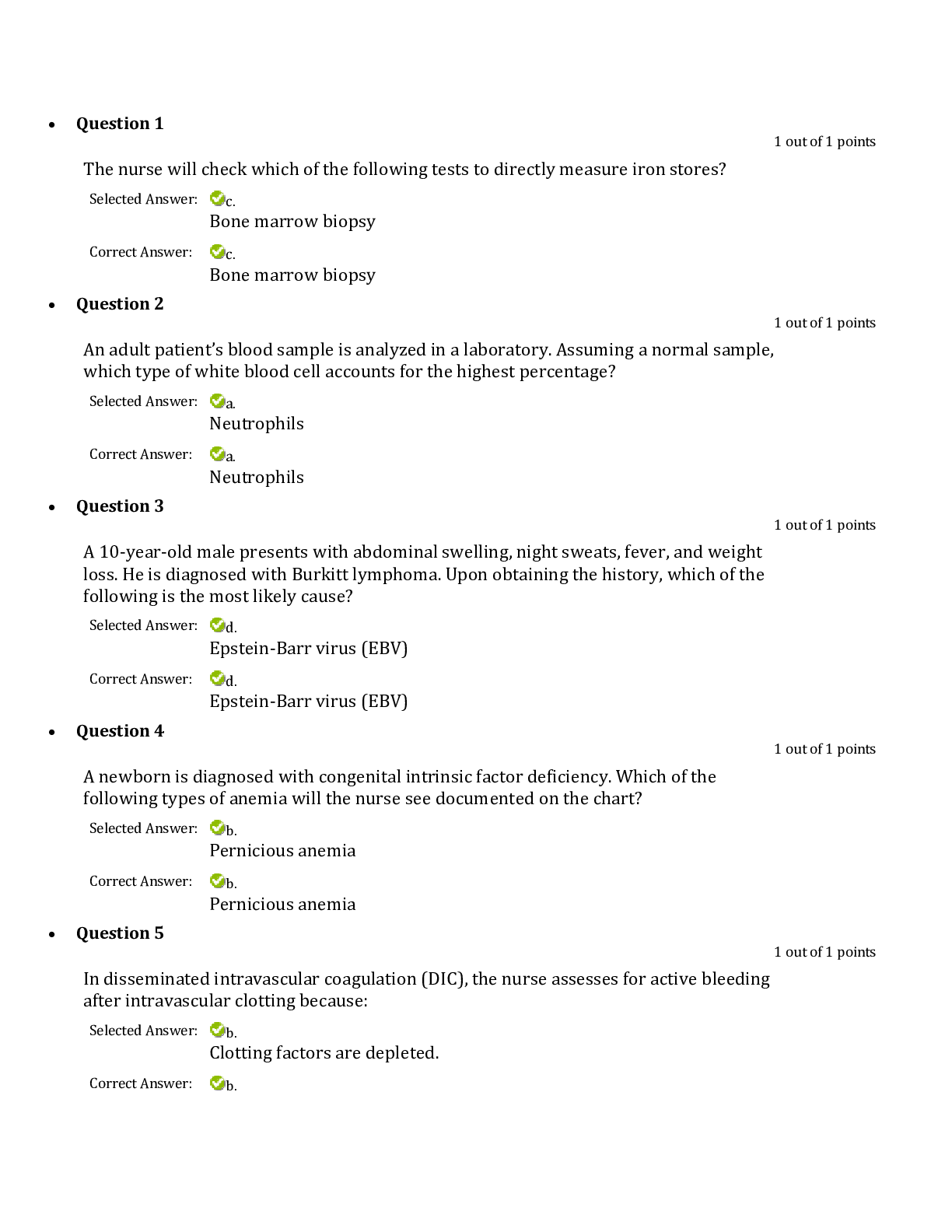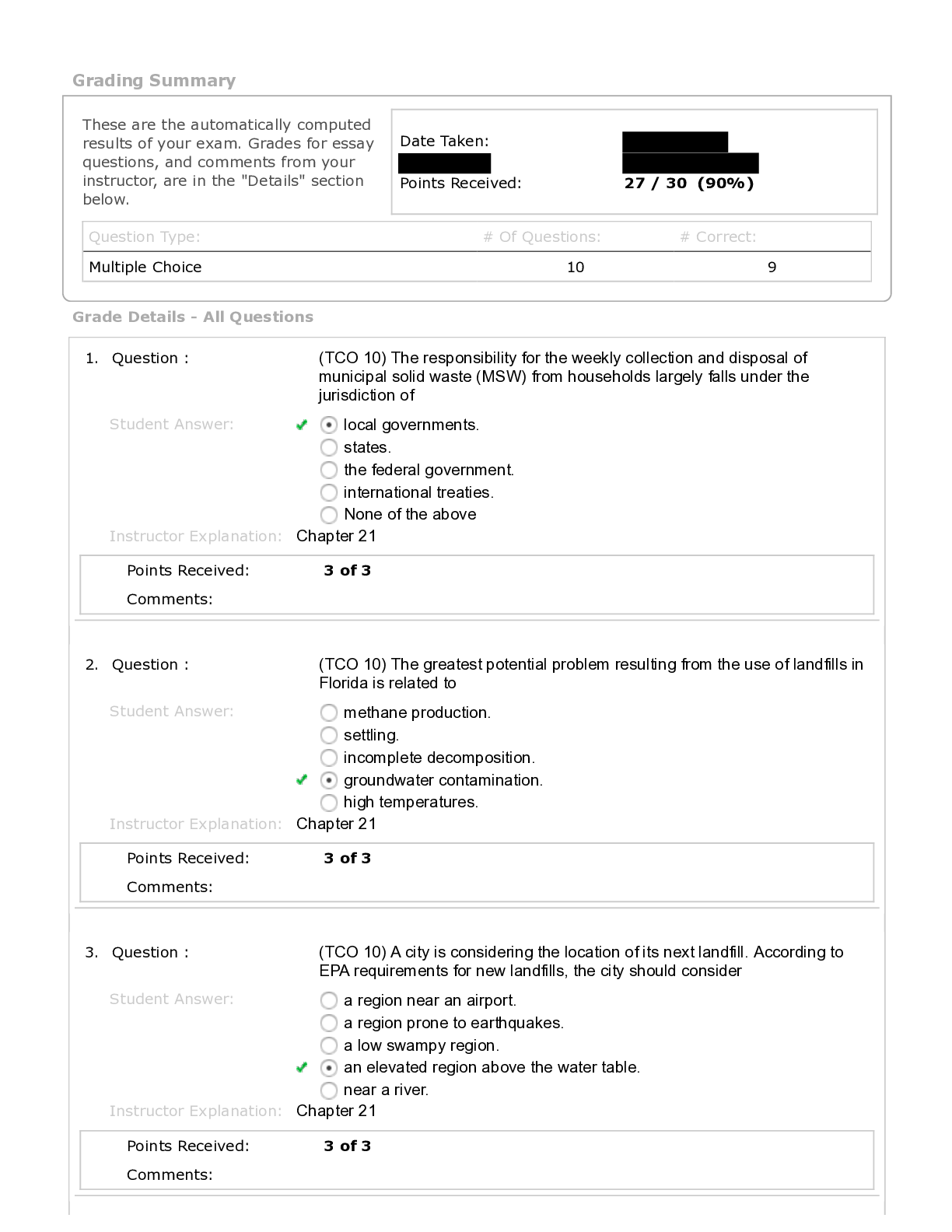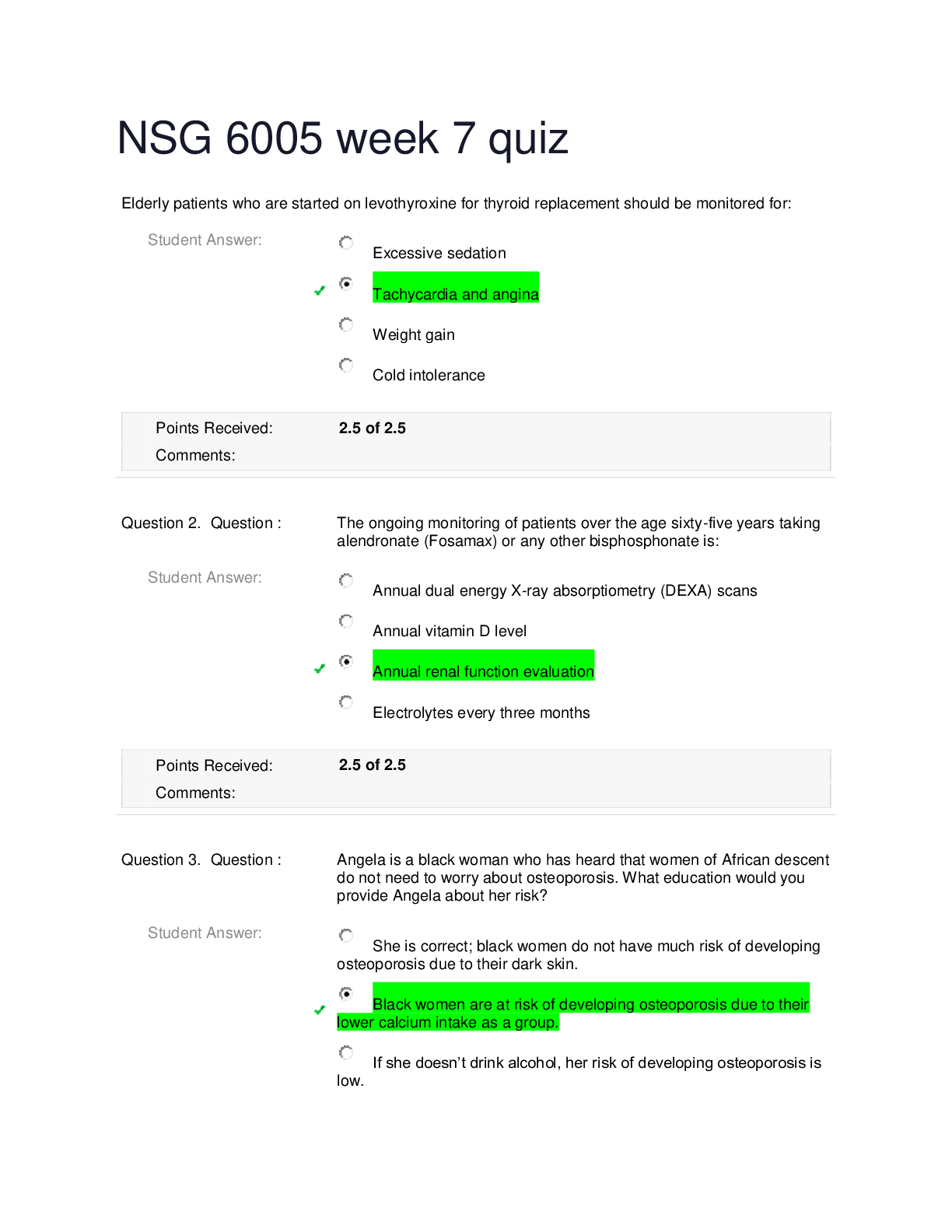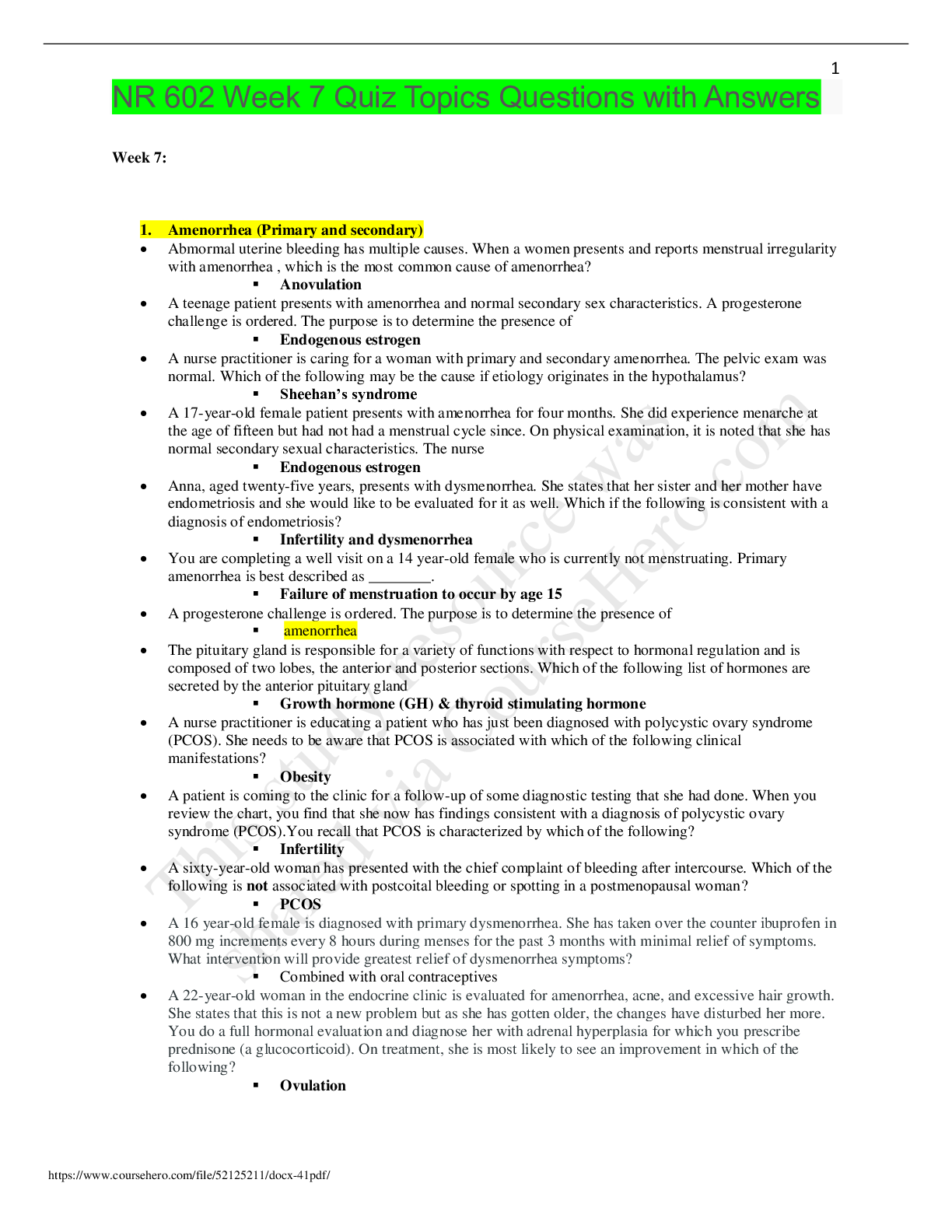NURS 6512 week 7 Quiz | Contains 20 Q&A | Walden University
Document Content and Description Below
NURS 6512 week 7 quiz • • Question 1 2 out of 2 points Costovertebral angle tenderness should be assessed whenever you suspect the patient may have: Response Feed-back: Pyelonephri... tis is characterized by flank pain and costovertebral an-gle tenderness. • Question 2 2 out of 2 points • Question 3 2 out of 2 points A 1-month-old boy has been vomiting for 2 weeks. How is this symptom of gas-troesophageal reflux disease (GERD) and pyloric stenosis further differentiated in this child s assessment? • Question 4 2 out of 2 points Auscultation of borborygmi is associated with: • Question 5 2 out of 2 points When auscultating the abdomen, which finding would indicate collateral circulation between the portal and systemic venous systems? • Question 6 2 out of 2 points Conversion of fat-soluble wastes to water-soluble material for renal excretion is a function of the: • Question 7 2 out of 2 points The major function of the large intestine is: • Question 8 2 out of 2 points Which structure is located in the hypogastric region of the abdomen? • Question 9 2 out of 2 points A 45-year-old man relates a several-week history of severe intermittent abdominal burning sensations. He relates that the pain is relieved with small amounts of food. Before starting the physical examination, you review his laboratory work, anticipating a(n): • Question 10 2 out of 2 points Percussion at the right midclavicular line, below the umbilicus, and continuing up-ward is the correct technique for locating the: • Question 11 2 out of 2 points Baby Joe is 6 months old. He has abdominal distention and vomiting and is inconsolable. A sausage-shaped mass is palpable in his right upper quadrant. Joe s lower quadrant feels empty, and a positive Dance sign is noted in his record. Which one of the following conditions is consistent with Baby Joe s symptoms? • Question 12 2 out of 2 points Mrs. G. is 7 months pregnant and states that she has developed a problem with con-stipation. She eats a well-balanced diet and is usually regular. You should explain that constipation is common during pregnancy due to changes in the colorectal areas, such as: • Question 13 2 out of 2 points A 51-year-old woman calls with complaints of weight loss and constipation. She re-ports enlarged hemorrhoids and rectal bleeding. You advise her to: • Question 14 2 out of 2 points When examining a patient with tense abdominal musculature, a helpful technique is to have the patient: • Question 15 2 out of 2 points The Joint Commission (TJC, formerly The Joint Commission on Accreditation of Healthcare Organizations [JCAHO]) requires that: • Question 16 2 out of 2 points A 5-year-old is complaining of nondescriptive "belly pain." Your next action should be to ask him to: • Question 17 2 out of 2 points Body language that leads you to suspect the person is in pain is: • Question 18 2 out of 2 points Mr. Green is a 68-year-old patient who has complained of pain. As the health care provider, you have decided to use a pain scale for documentation of the patient's pain. The value of the use of scales for patients to rate their pain intensity is that: • Question 19 2 out of 2 points Your trauma patient has no auscultated breath sounds in the right lung field. You can hear ade-quate sounds in the left side. A likely cause of this abnormality could be that the patient: • Question 20 2 out of 2 points Clear or amber drainage from the nose or ears of a blunt trauma patient may indicate: Chapter 17: Abdomen Test Bank—Medical MULTIPLE CHOICE 1. A serous membrane that lines the abdominal cavity and forms a protective cover for many abdominal structures is the a. peritoneum. b. mediastinum. c. linea alba. d. mesentery. e. pleura. REF: p. 370 TOP: Discipline: Gross Anatomy MSC: Organ System: Gastrointestinal 2. What part of the small intestine forms a C-shaped curve around the head of the pancreas? a. Duodenum b. Ileum c. Jejunum d. Falciform ligament e. Pylorus REF: p. 372 TOP: Discipline: Gross Anatomy MSC: Organ System: Gastrointestinal 3. Peristalsis of intestinal contents is under the control of a. cognitive processes. b. gravity. c. the autonomic nervous system. d. the fluid content of the stomach. e. cerebellum. REF: p. 372 TOP: Discipline: Physiology MSC: Organ System: Gastrointestinal 4. The esophagus travels a route from a. anterior to the trachea through the mediastinal cavity. b. lateral to the trachea through the diaphragm. c. left of the trachea through the peritoneum. d. the anterior trachea through the cardiac orifice. e. behind the trachea through the mediastinal cavity. REF: p. 372 TOP: Discipline: Gross Anatomy MSC: Organ System: Gastrointestinal 5. Which organ is part of the alimentary tract? a. Pancreas b. Stomach c. Gallbladder d. Liver e. Spleen REF: p. 372 TOP: Discipline: Gross Anatomy MSC: Organ System: Gastrointestinal 6. The superior most part of the stomach is the a. body. b. fundus. c. pylorus. d. cardiac orifice. e. pyloric orifice. REF: p. 372 TOP: Discipline: Gross Anatomy MSC: Organ System: Gastrointestinal 7. Which of the following is true regarding the stomach? a. It lies in the lower abdominal cavity. b. It secretes gastric lipase that serves to digest protein. c. Very little absorption takes place in the stomach. d. The stomach produces most of the body’s bile. e. Pancreatic enzymes directly enter the stomach. REF: p. 372 TOP: Discipline: Physiology MSC: Organ System: Gastrointestinal 8. The appendix is an extension of the a. ileum. b. cecum. c. ascending colon. d. transverse colon. e. descending colon. REF: p. 372 TOP: Discipline: Gross Anatomy MSC: Organ System: Gastrointestinal 9. When palpating the abdomen, you should note whether the liver is enlarged in the a. left upper quadrant. b. midepigastric region. c. periumbilical area. d. right upper quadrant. e. right lower quadrant. REF: p. 372 TOP: Discipline: Physiology MSC: Organ System: Gastrointestinal 10. One major function of the liver is to a. secrete pepsin. b. emulsify fats. c. store glycogen. d. absorb bile. e. produce insulin. REF: p. 373 TOP: Discipline: Physiology MSC: Organ System: Gastrointestinal 11. The majority of nutrient absorption takes place in the a. stomach. b. small intestine. c. cecum. d. transverse colon. e. descending colon. REF: p. 372 TOP: Discipline: Physiology MSC: Organ System: Gastrointestinal 12. The major function of the large intestine is a. water absorption. b. food digestion. c. carbohydrate absorption. d. mucous absorption. e. glycogen breakdown. REF: p. 372 TOP: Discipline: Physiology MSC: Organ System: Gastrointestinal 13. Conversion of fat-soluble wastes to water-soluble material for renal excretion is a function of the a. spleen. b. kidney. c. liver. d. pancreas. e. gallbladder. REF: p. 373 TOP: Discipline: Physiology MSC: Organ System: Gastrointestinal 14. Contraction of the gallbladder propels bile into the a. stomach. b. duodenum. c. jejunum. d. ileum. e. cecum. REF: p. 373 TOP: Discipline: Physiology MSC: Organ System: Gastrointestinal 15. Which abdominal organs also produce hormones and function as endocrine glands? a. Kidney and liver b. Liver and gallbladder c. Stomach and spleen d. Gallbladder and pancreas e. Pancreas and kidney REF: p. 373 TOP: Discipline: Physiology MSC: Organ System: Gastrointestinal 16. Which organ(s) are located in the retroperitoneal space? a. Kidneys b. Lungs c. Spleen d. Gallbladder e. Liver REF: p. 373 TOP: Discipline: Gross Anatomy MSC: Organ System: Gastrointestinal 17. Mrs. G is 7 months’ pregnant and states that she has developed a problem with constipation. She eats a well-balanced diet and is usually regular. You should explain that constipation is common during pregnancy because of changes in the colorectal areas, such as a. decreased movement through the colon and increased water absorption from stool. b. increased movement through the colon and increased salt taken from foods. c. looser anal sphincter and less nutrients taken from foods. d. tighter anal sphincter and less iron eliminated in the stool. e. increased absorption of nutrients and water in the colon. REF: p. 374 TOP: Discipline: Physiology MSC: Organ System: Gastrointestinal 18. The most pronounced functional change of the gastrointestinal (GI) tract in older adults is a. decreased hydrochloric acid production. b. increased motility. c. decreased bile absorption. d. decreased motility. e. increased saliva secretion. REF: p. 375 TOP: Discipline: Physiology MSC: Organ System: Gastrointestinal 19. The family history of a patient with diarrhea and abdominal pain should include inquiry about cystic fibrosis because it a. only affects the GI tract. b. is one cause of malabsorption syndrome. c. is a curable condition with medical intervention. d. is the most frequent cause of diarrhea in general practice. e. is a common genetic disorder. REF: p. 377 TOP: Discipline: Pathophysiology MSC: Organ System: Gastrointestinal 20. Infants born weighing less than 1500 g are at higher risk for a. hepatitis A. b. necrotizing enterocolitis. c. urinary urgency. d. cystic fibrosis. e. pancreatitis. REF: p. 377 TOP: Discipline: Biostatistics MSC: Organ System: Gastrointestinal 21. Inspection of the abdomen should begin with the patient supine and the examiner a. seated on the patient’s right side. b. standing at the foot of the table. c. standing at the patient’s left. d. walking around the table. e. seated on the patient’s left side. REF: p. 377 TOP: Discipline: Physiology MSC: Organ System: Gastrointestinal 22. Before performing an abdominal examination, the examiner should a. ascertain the patient’s HIV status. b. have the patient empty his or her bladder. c. don double gloves. d. completely disrobe the patient. e. uncover only the painful areas of the abdomen. REF: p. 377 TOP: Discipline: Physiology MSC: Organ System: Gastrointestinal 23. Which structure is located in the hypogastric region of the abdomen? a. Bladder b. Cecum c. Gallbladder d. Stomach e. Liver REF: p. 379 TOP: Discipline: Gross Anatomy MSC: Organ System: Gastrointestinal 24. When examining a patient with tense abdominal musculature, a helpful technique is to have the patient a. hold his or her breath. b. sit upright. c. flex his or her knees. d. raise his or her head off the pillow. e. fully extend the legs. REF: p. 383 TOP: Discipline: Physiology MSC: Organ System: Gastrointestinal 25. You ask the patient to raise the head and shoulders while lying in a supine position. A midline abdominal ridge rises. You chart this observation as a(n) a. small inguinal hernia. b. large epigastric hernia. c. abdominal lipoma. d. diastasis recti. e. incisional hernia. REF: p. 395 TOP: Discipline: Physiology MSC: Organ System: Gastrointestinal 26. What condition is associated with striae that remain purplish? a. Cushing disease b. Diastasis recti c. Liver cirrhosis d. Recent pregnancy e. Intraabdominal bleeding REF: p. 379 TOP: Discipline: Pathophysiology MSC: Organ System: Gastrointestinal 27. Visible intestinal peristalsis may indicate a. normal digestion. b. intestinal obstruction. c. increased pulse pressure of aorta. d. aortic aneurysm. e. paralytic ileus. ANS: B Peristalsis is not usually visible and when detected may indicate an intestinal obstruction. REF: p. 381 TOP: Discipline: Pathophysiology MSC: Organ System: Gastrointestinal 28. After thorough inspection of the abdomen, the next assessment step is to a. percuss. b. palpate nonpainful areas. c. auscultate. d. perform a rectal examination. e. palpate painful areas. REF: p. 381 TOP: Discipline: Physiology MSC: Organ System: Gastrointestinal 29. Auscultation of borborygmi is associated with a. gastroenteritis. b. peritonitis. c. satiety. d. paralytic ileus. e. stenotic arteries. REF: p. 381 TOP: Discipline: Physiology MSC: Organ System: Gastrointestinal 30. Peritonitis often produces bowel sounds that are a. decreased. b. increased. c. high pitched. d. absent. e. accentuated. 31. A patient is complaining of abdominal pain, nausea with vomiting, malaise, and a low-grade fever attributed to eating some “bad food” 4 hours ago. The abdomen is soft and rounded, with hypoactive bowel sounds after 5 minutes of auscultation to each quadrant. Which assessment finding is inconsistent with gastroenteritis? a. Malaise b. Low-grade fever c. Hypoactive bowel sounds d. Soft, rounded abdomen e. Abdominal pain REF: p. 381 TOP: Discipline: Pathophysiology MSC: Organ System: Gastrointestinal 32. An examiner can recognize a friction rub in the liver by a sound that is a. clicking, gurgling, and irregular. b. high pitched and associated with respirations. c. loud, prolonged, and gurgling. d. soft, low-pitched, and continuous. e. low pitched, tinkling, and unrelated to respirations. REF: p. 381 TOP: Discipline: Pathophysiology MSC: Organ System: Gastrointestinal 33. To correctly document absent bowel sounds, one must listen continuously for a. 30 seconds. b. 1 minute. c. 3 minutes. d. 5 minutes. e. 10 minutes. REF: p. 381 TOP: Discipline: Physiology MSC: Organ System: Gastrointestinal 34. Percussion at the right midclavicular line, below the umbilicus, and continuing upward is the correct technique for locating the a. descending aorta. b. lower liver border. c. medial border of the spleen. d. upper right kidney ridge. e. stomach. REF: p. 381 TOP: Discipline: Physiology MSC: Organ System: Gastrointestinal 35. When auscultating the abdomen, which finding would indicate collateral circulation between the portal and systemic venous systems? a. Arterial bruit b. Gastric rumbling c. Renal hyperresonance d. Borborygmi e. Venous hum REF: p. 381 TOP: Discipline: Pathophysiology MSC: Organ System: Gastrointestinal 36. Percussion of the abdomen begins with establishing a. liver dullness. b. spleen dullness. c. gastric bubble tympany. d. overall dullness and tympany in all quadrants. e. bladder fullness. REF: p. 381 TOP: Discipline: Physiology MSC: Organ System: Gastrointestinal 37. To assess for liver enlargement in an obese person, you should a. use the hook method. b. test for cutaneous hypersensitivity. c. auscultate using the scratch technique. d. attempt palpation during deep exhalation. e. have the patient lean over at the waist. REF: p. 386 TOP: Discipline: Physiology MSC: Organ System: Gastrointestinal 38. An umbilical assessment in the newborn that is of concern is a. a thick cord. b. an umbilical hernia. c. one umbilical artery and two veins. d. pulsations superior to the umbilicus. e. visible nondistended superficial veins. REF: p. 394 TOP: Discipline: Embryology MSC: Organ System: Gastrointestinal 39. Failure to pass a meconium stool in the first 24 hours after birth along with abdominal distention is often the first sign of a. Meckel diverticulum. b. cystic fibrosis. c. biliary atresia. d. hydramnios. e. Wilms tumor. REF: p. 411 TOP: Discipline: Pathophysiology MSC: Organ System: Gastrointestinal 40. When palpating the aorta, a prominent lateral pulsation suggests a. aortic aneurysm. b. normal pulsation. c. renal artery fistula. d. vena cava varicosity. e. coarctation. REF: p. 388 TOP: Discipline: Pathophysiology MSC: Organ System: Cardiovascular 41. A patient presents with symptoms that lead you to suspect acute appendicitis. Which assessment finding is least likely to be associated with this condition early in its course? a. Positive psoas sign b. Positive McBurney sign c. History of periumbilical pain d. Rebound tenderness e. Obturator muscle test REF: p. 393 TOP: Discipline: Pathophysiology MSC: Organ System: Gastrointestinal 42. When using the bimanual technique for palpating the abdomen, you should a. push down with the bottom hand and the other atop. b. push down with the top hand and the other atop. c. place hands side by side and push equally. d. place one hand anteriorly and the other posteriorly squeezing the hands together. e. make a fist with the top hand and strike the bottom hand. REF: p. 394 TOP: Discipline: Physiology MSC: Organ System: Gastrointestinal 43. A 23-year-old man comes to the urgent care clinic with intense left flank and lower left quadrant pain. One patient response to history of present illness questions that further supports a tentative diagnosis of renal calculi is a. “My urine has been bright yellow.” b. “I have had fever and chills for 2 days.” c. “I also have a headache and neck ache.” d. “My left testicle and shoulder hurt as well.” e. “I have had flatulence and foul-smelling urine.” REF: p. 391 TOP: Discipline: Pathophysiology MSC: Organ System: Renal/Urinary 44. Flatulence, diarrhea, dysuria, and tenderness with abdominal palpation are findings most associated with a. peptic ulcer disease. b. pancreatitis. c. ruptured ovarian cyst. d. splenic rupture. e. diverticulitis. REF: p. 390 TOP: Discipline: Pathophysiology MSC: Organ System: Gastrointestinal 45. A 45-year-old man relates a several-week history of severe intermittent abdominal burning sensations. He relates that the pain is relieved with small amounts of food. Before starting the physical examination, you review his laboratory work, anticipating a(n) a. elevated white blood cell count. b. decreased potassium level. c. positive Helicobacter pylori result. d. increased urine specific gravity. e. folate deficiency. REF: p. 401 TOP: Discipline: Pathophysiology MSC: Organ System: Gastrointestinal 46. A 51-year-old woman calls with concerns of weight loss and constipation. She reports enlarged hemorrhoids and rectal bleeding. You advise her to a. use topical over-the-counter hemorrhoid treatment for 1 week. b. exercise and eat more fiber. c. come to the laboratory for a stool guaiac test. d. eat six small meals a day. e. go to the emergency department for a barium enema. REF: p. 404 TOP: Discipline: Pathophysiology MSC: Organ System: Gastrointestinal 47. Patients presenting with ascites, jaundice, cutaneous spider veins, and nonpalpable liver exhibit signs of a. cholecystitis. b. pancreatitis. c. inflammatory bowel disease. d. diverticulitis. e. cirrhosis. REF: p. 404 TOP: Discipline: Pathophysiology MSC: Organ System: Gastrointestinal 48. A patient presents to the emergency department after a motor vehicle accident. The patient sustained blunt trauma to the abdomen and complains of pain in the upper left quadrant that radiates to the left shoulder. What organ is most likely injured? a. Gallbladder b. Liver c. Spleen d. Stomach e. Colon REF: p. 407 TOP: Discipline: Pathophysiology MSC: Organ System: Gastrointestinal 49. Costovertebral angle tenderness should be assessed whenever you suspect the patient may have a. cholecystitis. b. pancreatitis. c. pyelonephritis. d. ulcerative colitis. e. intussusception. REF: p. 408 TOP: Discipline: Pathophysiology MSC: Organ System: Renal/Urinary 50. Imaging studies reveal that a patient has dilation of the renal pelvis from an obstruction in the ureter. What condition will be documented in this patient’s health record? a. Glomerulonephritis b. Hydronephrosis c. Pyelonephritis d. Renal abscess e. Renal artery emboli REF: p. 408 TOP: Discipline: Pathophysiology MSC: Organ System: Renal/Urinary 51. The most common congenital anomaly of the gastrointestinal tract is a. biliary atresia. b. meconium ileus. c. intussusception. d. Meckel diverticulum. e. pyloric stenosis. REF: p. 412 TOP: Discipline: Embryology MSC: Organ System: Gastrointestinal 52. Baby Joe is 6 months old. He has abdominal distention and vomiting and is inconsolable. A sausage-shaped mass is palpable in his right upper quadrant. Joe’s lower quadrant feels empty, and a positive Dance sign is noted in his record. Which one of the following conditions is consistent with Baby Joe’s symptoms? a. Intussusception b. Kidney stones c. Meconium ileus d. Pyloric stenosis e. Necrotizing enterocolitis REF: p. 410 TOP: Discipline: Pathophysiology MSC: Organ System: Gastrointestinal 53. A mother brings her 2-year-old child for you to assess. The mother feels a lump whenever she fastens the child’s diaper. Nephroblastoma is likely for this child when your physical examination of the abdomen reveals a(n) a. fixed mass palpated in the hypogastric area. b. tender, midline abdominal mass. c. olive-sized mass of the right upper quadrant. d. nontender, slightly moveable, flank mass. e. sausage-shaped mass in the left upper quadrant. REF: p. 413 TOP: Discipline: Pathophysiology MSC: Organ System: Gastrointestinal 54. A 1-month-old boy has been vomiting for 2 weeks. How is this symptom of gastroesophageal reflux disease (GERD) and pyloric stenosis further differentiated in this child’s assessment? a. Vomiting becomes projectile with GERD. b. The infant has regurgitation with pyloric stenosis. c. An olive-sized mass of the right upper quadrant (RUQ) occurs with GERD. d. Normal stools are expected with pyloric stenosis. e. The fontanel becomes sunken with pyloric stenosis. REF: p. 410 TOP: Discipline: Pathophysiology MSC: Organ System: Gastrointestinal 55. Urinary incontinence that occurs from the inability to hold urine when the stimulus to urinate is perceived is called _____ incontinence. a. paralytic b. urge c. overflow d. functional e. stress REF: p. 415 TOP: Discipline: Pathophysiology MSC: Organ System: Renal/Urinary 56. In older adults, overflow fecal incontinence is commonly caused by a. malabsorption. b. parasitic diarrhea. c. Meckel diverticulum. d. fistula formation. e. fecal impaction. REF: p. 415 TOP: Discipline: Pathophysiology MSC: Organ System: Gastrointestinal [Show More]
Last updated: 7 months ago
Preview 5 out of 21 pages

Loading document previews ...
Buy this document to get the full access instantly
Instant Download Access after purchase
Buy NowInstant download
We Accept:

Reviews( 0 )
$9.00
Can't find what you want? Try our AI powered Search
Document information
Connected school, study & course
About the document
Uploaded On
Aug 13, 2019
Number of pages
21
Written in
Additional information
This document has been written for:
Uploaded
Aug 13, 2019
Downloads
0
Views
203

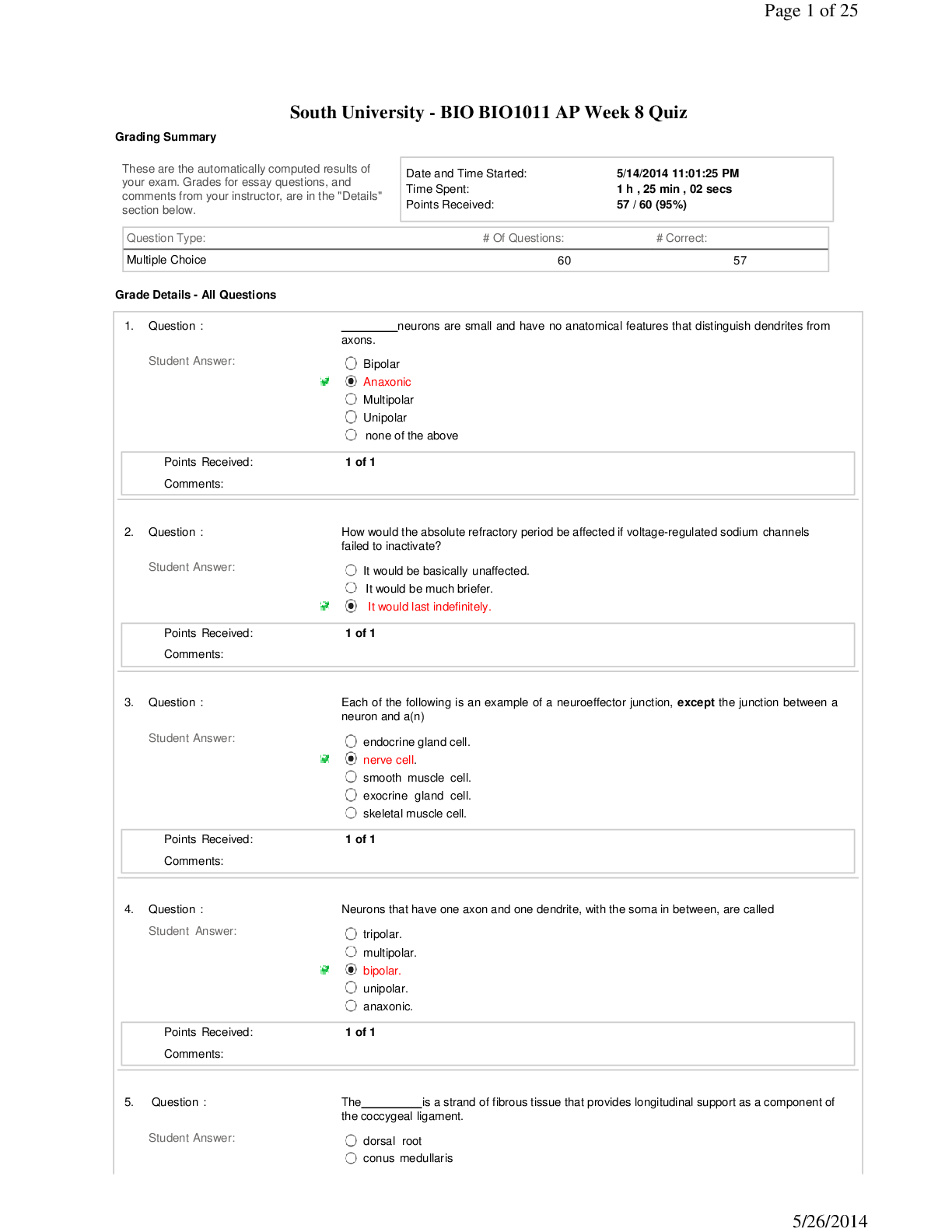
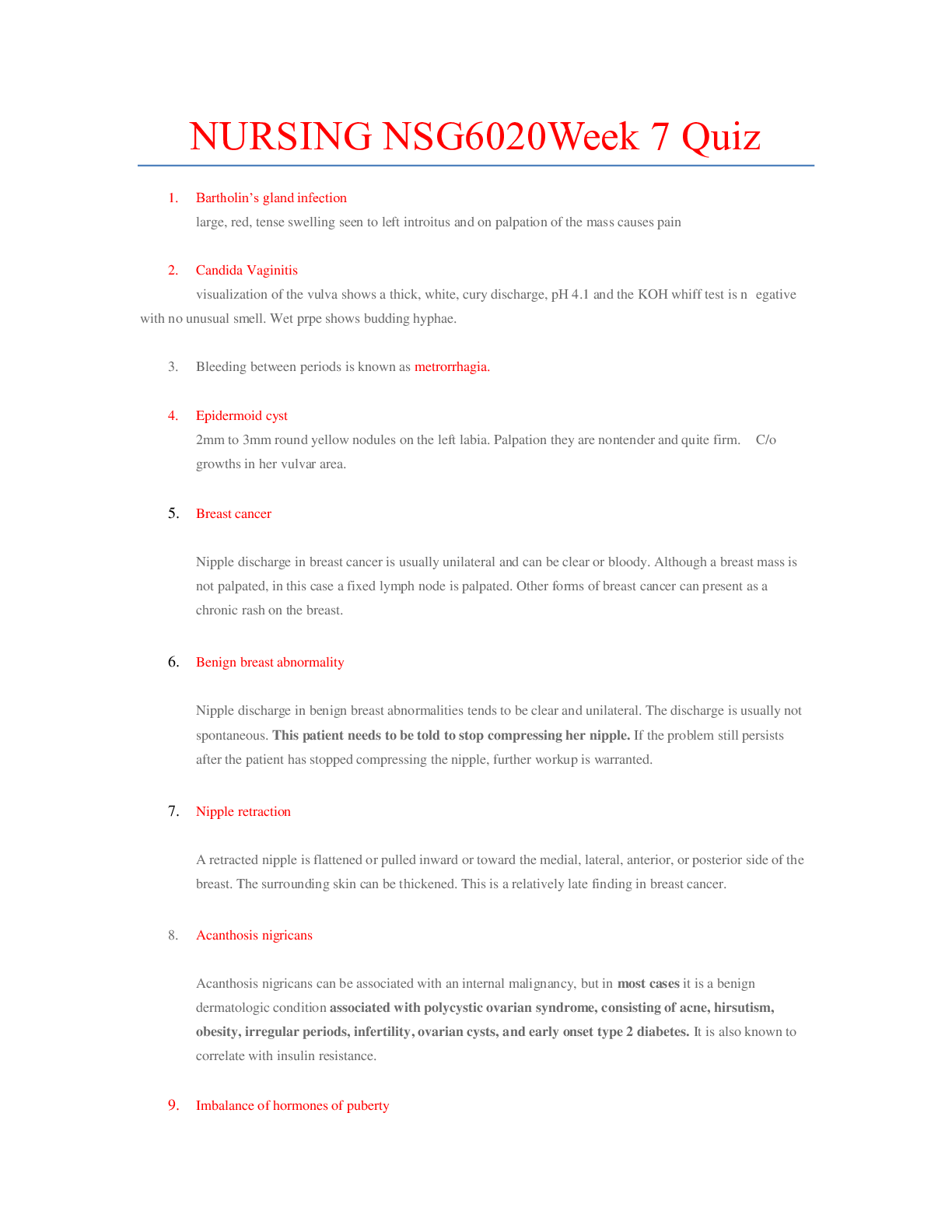
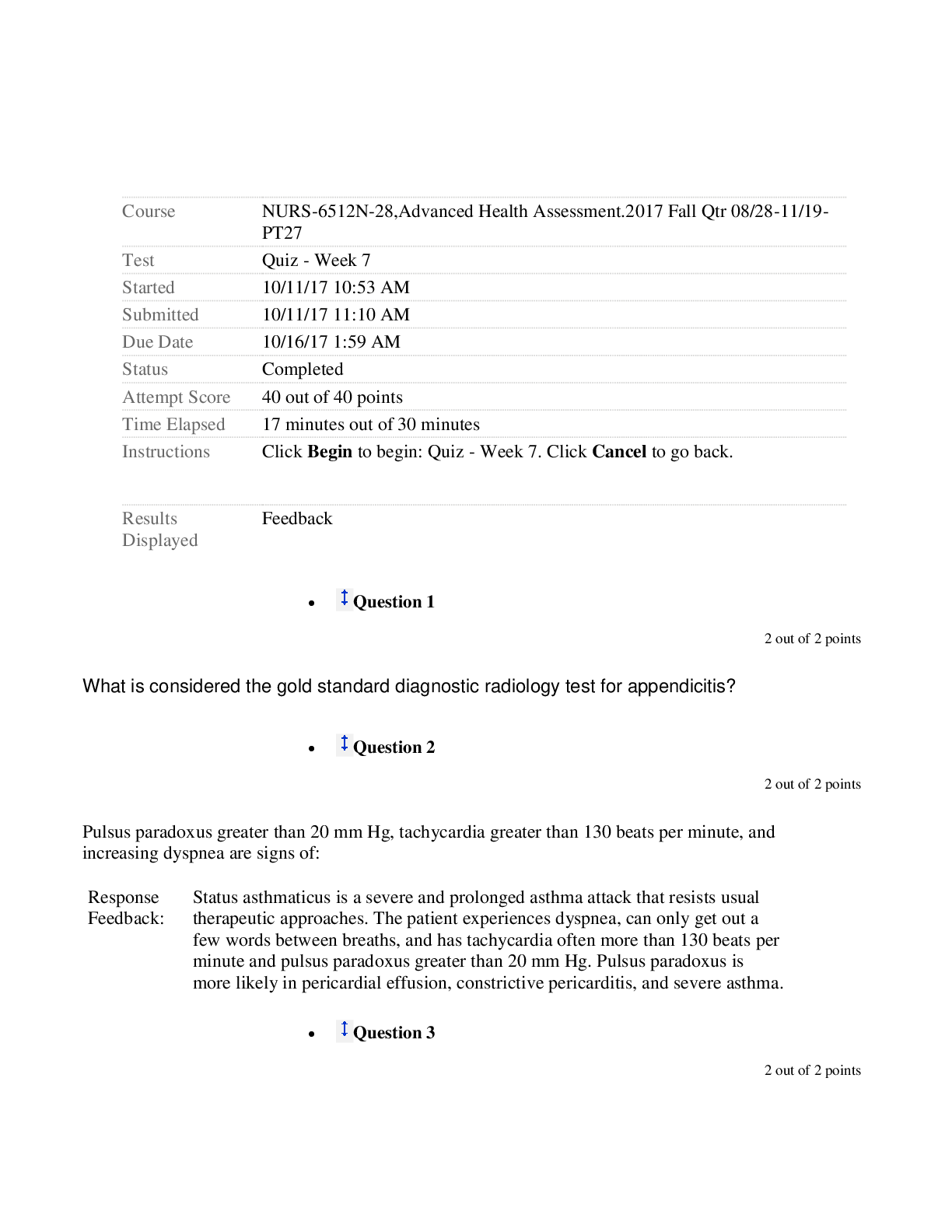



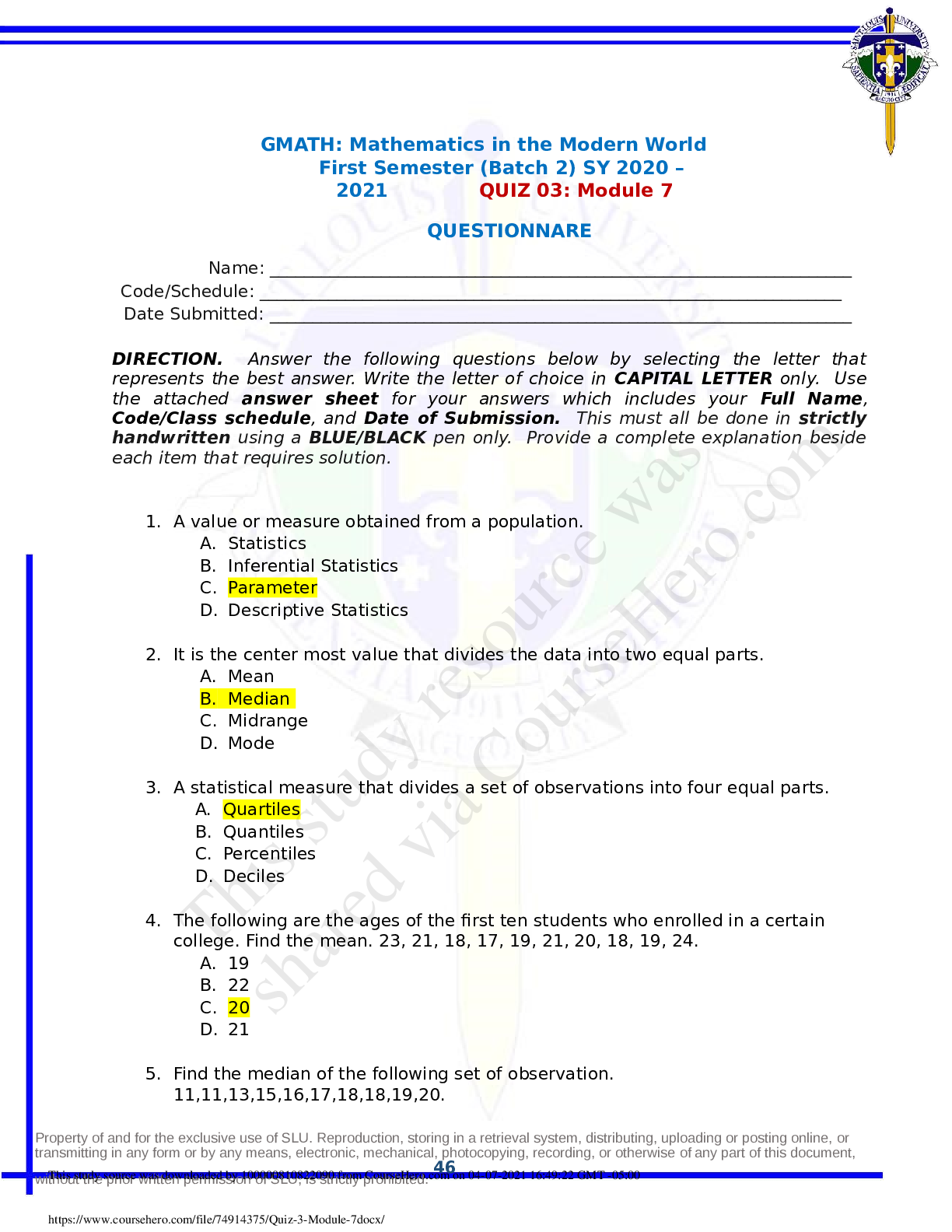



.png)

